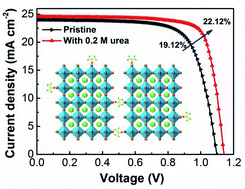High-performance perovskite solar cells resulting from large perovskite grain size enabled by the urea additive†
Abstract
Grain boundary and surface defects can be reduced by nucleation and crystallization management for designing high-quality perovskite films, which further improves the power conversion efficiency (PCE) and stability of perovskite solar cells (PSCs). Herein, high-quality perovskite films are prepared by a two-step method using urea, a typical Lewis base, as an additive. The formation of a PbI2·urea complex by doping urea additive into a PbI2 precursor can slow down the crystallization of PbI2, and facilitate the formation of large grain PbI2 film. The PbI2 films with large grains have fewer nucleation sites, leading to high-quality perovskite films with large grains, excellent crystallinity, and high coverage. The increase of grain size and decrease of grain boundary density led to a decrease in defect density and charge carrier recombination, which significantly improves the photovoltaic performance of PSCs. Finally, the best performance of the PSC device is obtained for 0.2 M urea as the additive, with a PCE of 22.12%, negligible hysteresis and great stability.



 Please wait while we load your content...
Please wait while we load your content...